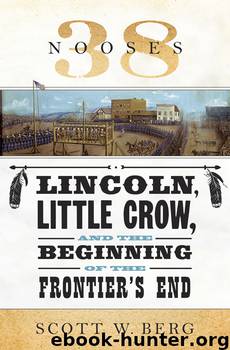38 Nooses by Scott W. Berg

Author:Scott W. Berg [Berg, Scott W.]
Language: eng
Format: epub
ISBN: 978-0-307-90739-4
Publisher: Knopf Doubleday Publishing Group
Published: 2012-12-03T16:00:00+00:00
Meanwhile, the arrests accelerated among the remaining Dakota near Camp Release, a succession of moments that were terrifying for his Dakota charges and troubling, if no more, to Sibley himself, who wrote to his wife that “the poor women’s wailings, when separated from their husbands, fathers, and sons are piteous indeed, and I dislike to go in person to their lodges, when I have orders for their removal.” He also noted that any qualms about the process were lessened by the discovery in some tents of dresses, wallets, jewelry, shoes, and other personal items from killed or captured whites. The makeshift log jail at Camp Release swelled to capacity and was placed under heavy guard as Sibley prepared to fulfill the second part of Pope’s orders and move all of the Dakota down to the Lower Agency, where the trials would continue and the executions begin.
Years later a sergeant named A. P. Connolly who had been stationed at Camp Release would write that “the orders were very strict about guarding the Indians, but on the sly many acts of cruelty were indulged in by the soldiers that would hardly be warranted, for we should not for a moment forget the fact that they were our prisoners and we were not savages and should not indulge in savage propensities.” And another officer, Thomas Watts, would tell a newspaper editor that some of the younger men had developed a plan to slaughter all of the Dakota under their watch: “At a given signal the guard surrounding the camp was to retire, then the battery was to shell the camp and the infantry was to do its work, and what was left, if any, the cavalry was to finish.” Sibley thought such threats serious enough that he gathered his troops and threatened courts-martial, following which his officers spoke to their respective companies. “It was promised that the Indians should be court marshaled immediately,” Watts wrote, “and that we should have the privilege of hanging the guilty ones.” Protecting the Dakota was, their commanders urged, a way of reserving the right to kill the Dakota themselves.
On October 12, one or two days after the mass arrests at the Upper Agency, the skies opened up, leaving the procession to travel over mile after mile of slick, rutted road. Early the following morning, the Renville Rangers, the partial company of white and mixed-blood soldiers raised by Thomas Galbraith, led the great convoy away from the Upper Agency. Infantry, wagons, oxcarts, cattle, cannon, and howitzers moved through the slop as a northern winter wind descended in all its fury. Some miles behind them followed Sibley with his men and his prisoners, two dozen of them, including Chaska, already condemned to death. All told, several hundred soldiers, nearly four hundred prisoners, and twelve hundred women, children, and elderly Dakota trudged in two miserable lines toward the Lower Agency, where the skeletal forms of more burned buildings still stood open to the early-winter air, and makeshift graves dotted the earth.
Download
This site does not store any files on its server. We only index and link to content provided by other sites. Please contact the content providers to delete copyright contents if any and email us, we'll remove relevant links or contents immediately.
| African-American Studies | Asian American Studies |
| Disabled | Ethnic Studies |
| Hispanic American Studies | LGBT |
| Minority Studies | Native American Studies |
Cecilia; Or, Memoirs of an Heiress — Volume 1 by Fanny Burney(31327)
Cecilia; Or, Memoirs of an Heiress — Volume 3 by Fanny Burney(30929)
Cecilia; Or, Memoirs of an Heiress — Volume 2 by Fanny Burney(30886)
The Great Music City by Andrea Baker(21197)
We're Going to Need More Wine by Gabrielle Union(18067)
Bombshells: Glamour Girls of a Lifetime by Sullivan Steve(13102)
Pimp by Iceberg Slim(12924)
All the Missing Girls by Megan Miranda(12741)
Fifty Shades Freed by E L James(12445)
Norse Mythology by Gaiman Neil(11877)
Talking to Strangers by Malcolm Gladwell(11865)
Crazy Rich Asians by Kevin Kwan(8343)
Mindhunter: Inside the FBI's Elite Serial Crime Unit by John E. Douglas & Mark Olshaker(7831)
The Lost Art of Listening by Michael P. Nichols(6465)
Enlightenment Now: The Case for Reason, Science, Humanism, and Progress by Steven Pinker(6404)
Bad Blood by John Carreyrou(5763)
The Four Agreements by Don Miguel Ruiz(5504)
Weapons of Math Destruction by Cathy O'Neil(5032)
We Need to Talk by Celeste Headlee(4863)
